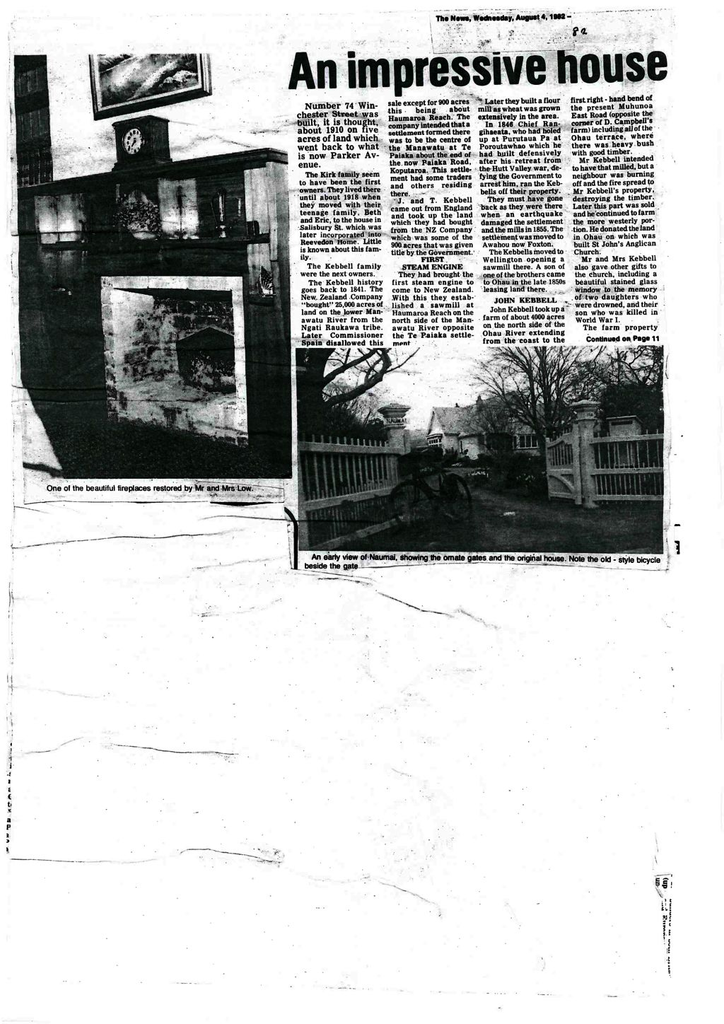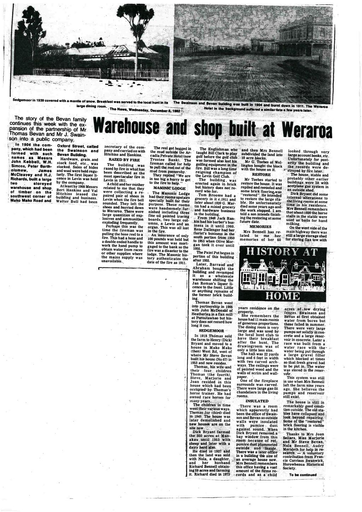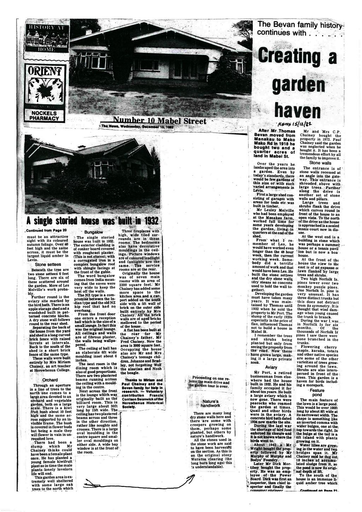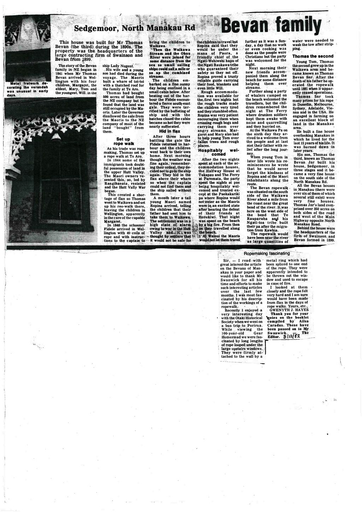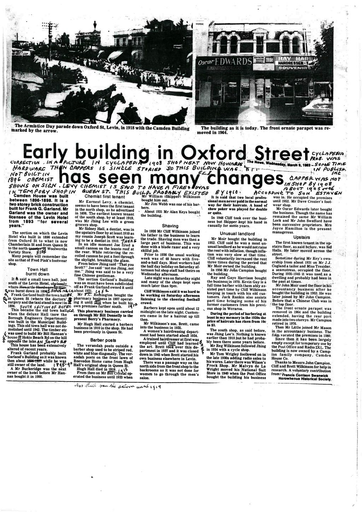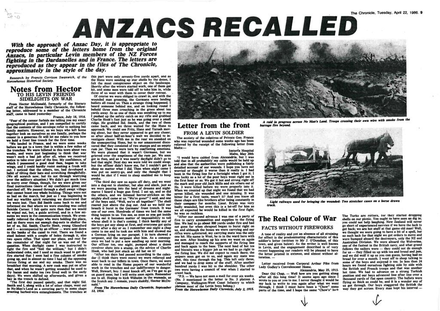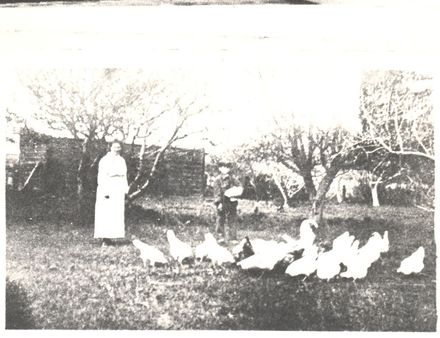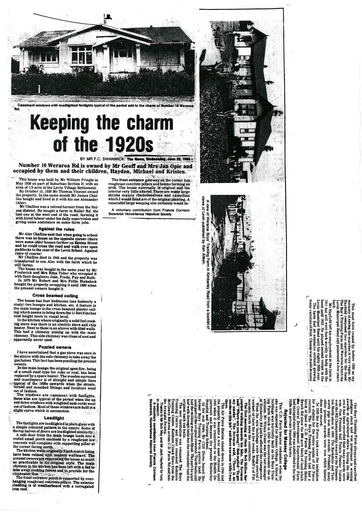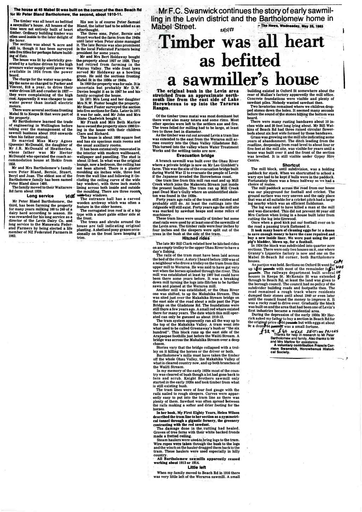An impressive house
- Description
 The Kirk family seem to have been the first owners. They lived there until about 1918 when they moved with their teenage family, Beth and Eric, to the house in Salisbury St, which was later incorporated into Reevedon Home. Little is known about this family.
The Kirk family seem to have been the first owners. They lived there until about 1918 when they moved with their teenage family, Beth and Eric, to the house in Salisbury St, which was later incorporated into Reevedon Home. Little is known about this family. The Kebbell history goes back to 1841. The New Zealand Company “bought” 25,000 acres of land on the lower Manawatu River from the Ngati Raukawa tribe. Later Commissioner Spain disallowed this sale except for 900 acres this being about Haumaroa Reach. The company intended that a settlement formed there was to be the centre of the Manawatu at Te Paiaka, about the end of the now Paiaka Road, Koputaroa. This settlement had some traders and others residing there.
J. and T. Kebbell came out from England and took up the land which they had bought from the NZ Company which was some of the 900 acres that was given title by the Government.
FIRST STEAM ENGINE
They had brought the first steam engine to come to New Zealand. With this they established a sawmill at Haumaroa Reach on the north side of the Manawatu River opposite the Te Paiaka settlement.
Later they built a flour mill as wheat was grown extensively in the area.
In 1846 Chief Rangihaeta, who had holed up at Purutaua Pa at Poroutawhao which he had built defensively after his retreat from the Hutt Valley war, defying the Government to arrest him, ran the Kebbells off their property.
They must have gone back as they were there when an earthquake damaged the settlement and the mills in 1855. The settlement was moved to Awahou now Foxton.
The Kebbells moved to Wellington opening a sawmill there. A son of one of the brothers came to Ohau in the late 1850s leasing land there.
JOHN KEBBELL
John Kebbell took up a farm of about 4000 acres on the north side of the Ohau River extending from the coast to the first right-hand bend of the present Muhunoa East Road (opposite the corner of D. Campbell’s farm) including all of the Ohau terrace, where there was heavy bush with good timber.
Mr. Kebbell intended to have that milled, but a neighbour was burning off and the fire spread to Mr. Kebbell’s property, destroying the timber. Later this part was sold and he continued to farm the more westerly portion. He donated the land in Ohau on which was built St. John’s Anglican Church.
Mr and Mrs Kebbell also gave other gifts to the church, including a beautiful stained glass window to the memory of two daughters, who were drowned, and their son who was killed in World War 1.
The farm property was originally leased from the former Maori owners, but was freeholded as opportunity offered.
The farm was originally called Ohau. When the coaches from Wellington (Paekakariki) to Foxton, river mouths had to have men in charge to watch the fords and lead the coach horses across the safest part. During this period Mr Kebbell was in charge of the Ohau mails, which he distributed.
With the completion of the Manawatu Railway line in 1886, the coaches no longer brought mail up the coast, and the men who had kept the fords open were paid off. The village centre was transferred to its present position, near the railway station called Ohau.
To avoid confusion, Mr Kebbell changed the name of the farm to Te Rauawa, ‘The sideboard of a canoe’, because a board forming the sideboard of a canoe had been used as part of the door frame of the first cottage built by Mr Kebbell on the property. The later residence had about 15 rooms.
Mrs Kebbell had to travel along the coast to Wellington for the birth of her children. At the time of Mrs. Marjorie Kirkcaldie’s birth the older children were left in the care of someone at their home. It was at this time that two of the little girls were drowned in the river.
When Horowhenua County broke away from Manawatu County in 1885, there were only 117 ratepayers. The first chairman held office for only a few months, and then Mr Kebbell became chairman and held office for a number of years. The county office was originally at Otaki, but with the establishment of Levin (around 1897) the office was built in Levin.
Later the Borough Council shared the building (opposite the Chronicle).
The family retired to Levin in 1918.
Their home was Number 74 Winchester Street, Levin, for many years known as Naumai, an impressive half-timbered house with steep gabled roof covered with diamond shaped tiles. There are four bedrooms, a study-dining room, living room, kitchen, pantry and bathroom. A passage about ten feet wide runs from front to back. Ceilings are high, and all joinery is of a high standard. Four rooms had fireplaces and there was a coal range in the kitchen.
The sunporch on the western side may have been an early addition. About 1928 an extension was made to two small bedrooms at the south-east corner. A fairly recent extension was made to bring out the north side of the kitchen. A large garage on the property, of matching design, seems to have been originally intended for the days of horse drawn vehicles, having a mezzanine area for storage.
EARLY COTTAGE
A cottage behind the house was probably one of the very early buildings of Levin, and it is suggested that the builder (or builders) lived there while building the large house. It contains three interconnecting rooms, and a toilet. This building became the laundry, workshop and tool room, these rooms used by Mr Kebbell who was a woodwork hobbyist.
The section was very large, with some fine trees. An extensive and colourful garden, well maintained, was for many years one of Levin’s show places. Up to about 1930 there was a large orchard on the southern part of the section, but this area was sold and a residence built on it.
The back garden was well stocked with small fruits and many vegetables. There was also a fowl run and ample room for grazing a horse. The rear of the section was cut off for subdivision with access from Parker Avenue when that street was opened up. A narrow strip along the north side of the section was added to the grounds of the Maternity Hospital.
A curved driveway lined with laburnums and bronze-leaved plum trees with a carpet of daffodils swept from Winchester Street at the north west corner and around the north side of the house. The rest of the frontage had a 20 foot macrocarpa hedge giving shelter to a grass tennis court.
John Kebbell and his wife Mary Grace and their eldest daughter Gertrude came to Naumai and were probably the ones who gave the property that name. They came from Te Rauawa, Muhunoa West Road, Ohau. Their only son was killed in World War 1, which was probably the deciding factor in selling the farm at Ohau and retiring to Levin. The youngest daughter Alison left school soon after and came to join them at Naumai. The second daughter, Marjorie, married to Norman Kirkcaldie lived at Kowhai beside Horowhenua Lake about this time.
Mr Kebbell was a good many years older than his wife. They both lived to around ninety years of age. The two daughters who had been at home both married after Mr Kebbell’s death, and at the conclusion of World War 11 Mrs Kirkcaldie came to Naumai to look after her mother.
After Mrs Kebbell’s death, Mrs Kirkcaldie continued to live there till 1971 when she went to live in Cambridge Street north, and Naumai was sold to R. McKenzie. He made the kitchen alterations previously mentioned and put the drive leading in from the south west corner of the section. Flats were built across the frontage of the property.
A house of similar architecture in Bath Street was latterly the home of the John Ryder family until sold to the Church of the Latter Day Saints. It was used for their meetings for a while, until demolished to make way for their present church.
HOSPITALITY
The name Naumai (welcome) is an appropriate one. The grounds of Naumai were often used for garden parties, for various worthy causes especially for functions of the Levin Anglican Church with which the Kebbells were closely identified. The fruits of the orchard were generously given away or made into jam and marmalade in large quantities for bazaars. The house and grounds were shared with a great many people who enjoyed its hospitality.

 Early this year 1982, Rosemary and Murray Low bought the property. They intend to restore to their original state the rooms that have been modernised.
Early this year 1982, Rosemary and Murray Low bought the property. They intend to restore to their original state the rooms that have been modernised. Some of the ceilings have been slightly lowered and covered with pinex panels. These will be reverted to the original ceilings. The main fireplace will also be restored back to its original condition.
The most distinctive feature left is a combined fireplace surround and wardrobe with bronze plaques set in the wardrobe front.
One feature I have not seen before is that in one of the rooms with original wall lining where the wallpaper has peeled back is that instead of rough lining timber, planed boards were used.
The section is still of 1¾ acres with a section width frontage with splayed corners in the title which at present are in the fence lines of the adjoining flats. This will enable Mr and Mrs Low to restore the original fence and gates which they are desirous of doing. If anyone has this type of gate for disposal please ring Mr Low phone 89-325.
Identification
- Date
- August 4, 1982
Taxonomy
- Community Tags


